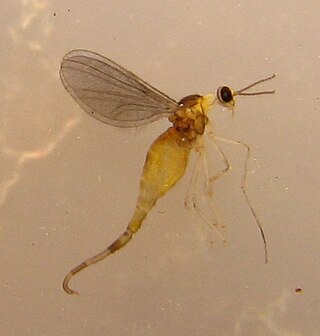
A midge is any small fly, including species in several families of non-mosquito Nematoceran Diptera. Midges are found on practically every land area outside permanently arid deserts and the frigid zones. Some midges, such as many Phlebotominae and Simuliidae, are vectors of various diseases. Many others play useful roles as prey for insectivores, such as various frogs and swallows. Others are important as detritivores, and form part of various nutrient cycles. The habits of midges vary greatly from species to species, though within any particular family, midges commonly have similar ecological roles.

Asphondylia is a cosmopolitan genus of gall midges in the family Cecidomyiidae. All species in this genus induce galls on plants, especially on flowers and flower buds. There are over 300 described species in Asphondylia, with many more likely to be discovered and described, especially in the southern hemisphere.

Asphondyliini is a tribe of gall midges in the family Cecidomyiidae. There are about six genera and at least 100 described species in Asphondyliini.

Rhopalomyia is a genus of gall midges, insects in the family Cecidomyiidae. There are at least 267 described species in Rhopalomyia. Most species in this genus induce galls on plants in the Asteraceae. This genus has a cosmopolitan distribution. Rhopalomyia was first established by Ewald Heinrich Rübsaamen in 1892.

Oligotrophini is a tribe of gall midges, insects in the family Cecidomyiidae. There are at least 20 genera and 300 described species in Oligotrophini.
Neolasioptera is a genus of gall midges, insects in the family Cecidomyiidae. There are at least 130 described species in Neolasioptera.
Bremia is a genus of gall midges. There are at least 20 described species in Bremia.
Paradiplosis is a genus of gall midges, insects in the family Cecidomyiidae. There are at least four described species in Paradiplosis.
Thecodiplosis is a genus of gall midges, insects in the family Cecidomyiidae. There are about six described species in Thecodiplosis.
Catotricha is a genus of midges in the family Cecidomyiidae. The five described species in Catotricha are found in the holarctic region. This genus was established by British entomologist Frederick Wallace Edwards in 1938.
Micromyini is a tribe of wood midges, insects in the family Cecidomyiidae. There are about 9 genera and at least 30 described species in Micromyini.
Micromyinae is a subfamily of wood midges, insects in the family Cecidomyiidae. Its members were formerly included in subfamily Lestremiinae. There are at least 55 genera and more than 650 described species in Micromyinae. All species in this subfamily are mycophageous.

Winnertziinae is a subfamily of gall midges and wood midges in the family Cecidomyiidae.
Sackenomyia is a genus of gall midges, insects in the family Cecidomyiidae. There are about five described species in Sackenomyia.

Olpodiplosis is a monotypic genus of gall midges, insects in the family Cecidomyiidae. The only described species is Olpodiplosis helianthi.
Pilodiplosis is a genus of gall midges, insects in the family Cecidomyiidae. There is at least one described species in Pilodiplosis, P. helianthibulla.
Miastor is a genus of gall midges and wood midges in the family Cecidomyiidae. There are about seven described species in Miastor.
Mycophila is a genus of wood midges, insects in the family Cecidomyiidae. There are seven described species in Mycophila. The genus was established by Ephraim Porter Felt in 1911.
Anabremia is a genus of gall midge in the family Cecidomyiidae. The six described species are found in the Palearctic and likely inquilines of Dasineura galls on plants in the legume family. This genus was first described by Jean-Jacques Kieffer in 1912.
Forbesomyia is a genus of wood midges, insects in the family Cecidomyiidae. The one described species - Forbesomyia atra - is known from North America. The genus was established by Scottish entomologist John Russell Malloch in 1914.






